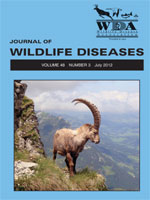Marine mammals are at risk for infection by fecal-associated zoonotic pathogens when they swim and feed in polluted nearshore marine waters. Because of their tendency to consume 25–30% of their body weight per day in coastal filter-feeding invertebrates, southern sea otters (Enhydra lutris nereis) can act as sentinels of marine ecosystem health in California. Feces from domestic and wildlife species were tested to determine prevalence, potential virulence, and diversity of selected opportunistic enteric bacterial pathogens in the Monterey Bay region. We hypothesized that if sea otters are sentinels of coastal health, and fecal pollution flows from land to sea, then sea otters and terrestrial animals might share the same enteric bacterial species and strains. Twenty-eight percent of fecal samples tested during 2007–2010 were positive for one or more potential pathogens. Campylobacter spp. were isolated most frequently, with an overall prevalence of 11%, followed by Vibrio cholerae (9%), Salmonella spp. (6%), V. parahaemolyticus (5%), and V. alginolyticus (3%). Sea otters were found positive for all target bacteria, exhibiting similar prevalences for Campylobacter and Salmonella spp. but greater prevalences for Vibrio spp. when compared to terrestrial animals. Fifteen Salmonella serotypes were detected, 11 of which were isolated from opossums. This is the first report of sea otter infection by S. enterica Heidelberg, a serotype also associated with human clinical disease. Similar strains of S. enterica Typhimurium were identified in otters, opossums, and gulls, suggesting the possibility of land-sea transfer of enteric bacterial pathogens from terrestrial sources to sea otters.
How to translate text using browser tools
1 July 2012
EPIDEMIOLOGY AND POTENTIAL LAND-SEA TRANSFER OF ENTERIC BACTERIA FROM TERRESTRIAL TO MARINE SPECIES IN THE MONTEREY BAY REGION OF CALIFORNIA
Stori C. Oates,
Melissa A. Miller,
Barbara A. Byrne,
Nadira Chouicha,
Dane Hardin,
David Jessup,
Clare Dominik,
Annette Roug,
Alexander Schriewer,
Spencer S. Jang,
Woutrina A. Miller
ACCESS THE FULL ARTICLE

Journal of Wildlife Diseases
Vol. 48 • No. 3
July 2012
Vol. 48 • No. 3
July 2012
Campylobacter
fecal bacterial pathogen
Salmonella
sea otter
Vibrio




